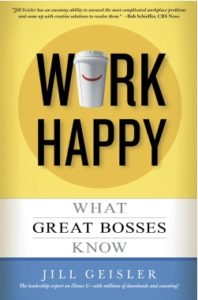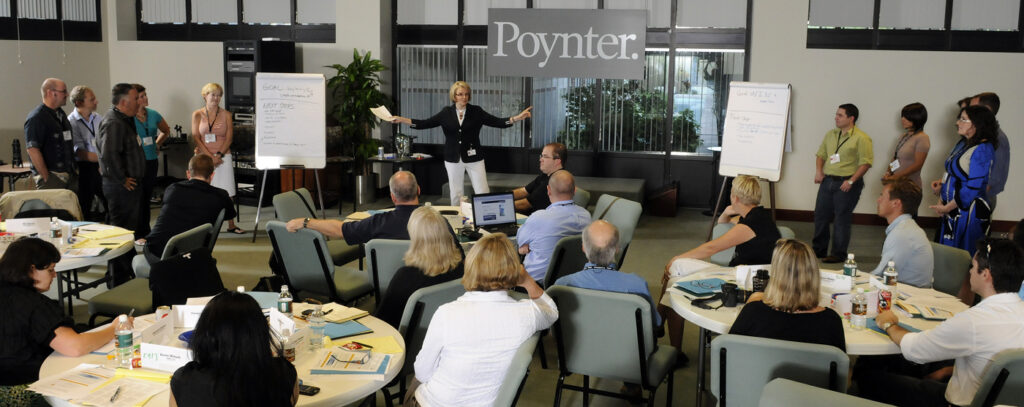On a recent business trip, I was reading Work Happy at breakfast. A server walking by noticed the book’s title and said, “I’m all for that! Who doesn’t want to be happy at work?” Then we started talking about what makes a great workplace.
The author of the book is Jill Geisler. She leads the management faculty at the Poynter Institute. She has one of the most popular management podcasts, “What Great Bosses Know,” with over seven million downloads on iTuneU. When I read her book, Work Happy: What Great Bosses Know, I was thrilled to find so much excellent management advice packed into a single book.
I didn’t just read the book; I put it to immediate use. For instance, I recently followed some of her advice on giving feedback. It was remarkably well-received, and I credit Jill for that. In another example, how do you answer an employee who stops you and says, “Got a minute?” when you truly are swamped and don’t have 20 seconds. Jill offers tips that I have already used.
Why didn’t you write this book much earlier in my career? You could have saved me from making many mistakes! What inspired you to write it?
Skip, you and I apparently share the same goal: to help managers avoid the mistakes we made as bosses! Your blog is a great contribution to that end, and for my part, I’ve been teaching, coaching, writing columns and producing podcasts on leadership and management in my faculty role at the Poynter Institute. But the book’s inspiration came from discovering that my “What Great Bosses Know” podcasts on iTunes U have been downloaded millions of times by people all over the world. It was evidence of an unsatisfied hunger for credible, practical help among men and women on the frontlines of leadership. That’s why I wrote this workshop-in-a-book.
One of the first things I remember in the book was the difference between “leadership characteristics” and “evil twins.” I often say that your greatest strength can also be your greatest weakness. This seems to show that concept in a different way. Explain the difference between the two and what to do about it.
 I developed my “Evil Twin” theory after working with many managers whose 360-degree feedback reports revealed a clear disconnect between what they aspire to be and how they are perceived by others. These managers are good people, trying to do the right thing—but they are shocked to discover that while they may see themselves as “The Boss Who Will Always Roll Up My Sleeves and Help,” staffers see their Evil Twin, “The Micromanager.” The opportunities for Evil Twins to mess with a manager’s success are endless.
I developed my “Evil Twin” theory after working with many managers whose 360-degree feedback reports revealed a clear disconnect between what they aspire to be and how they are perceived by others. These managers are good people, trying to do the right thing—but they are shocked to discover that while they may see themselves as “The Boss Who Will Always Roll Up My Sleeves and Help,” staffers see their Evil Twin, “The Micromanager.” The opportunities for Evil Twins to mess with a manager’s success are endless.
To keep Evil Twins at bay, be as transparent as possible about your intentions and never assume employees can read your mind. If you are open to candid feedback about your own performance, your employees will give you warnings about Evil Twin sightings. And if you take the quizzes and self-diagnostics in my book, you may also get some new insights into how easily your Twin can sneak up on you.
A saying I use frequently is, “Leaders are always on stage.” You say, “You are a walking billboard, boss. What’s your message?” How do you help new managers adjust to this reality?
Managers—whether novice or veteran—miss a terrific opportunity to lead if they fail to recognize the potential impact they have in their everyday interactions, knowing just how closely people watch them for signs and signals. It takes emotional intelligence—the ability to read people, to take the temperature of a group, or to sense tension, confusion, defeatism or wonderful optimism in a room—and immediately respond in ways that make things better. If you start with the understanding that you are on stage, or a walking billboard, you can turn it into a great asset at every turn, telegraphing just the right message for the moment.
New managers often believe they lack the standing to act that deliberately. Too many assume that they have a neon sign on their heads that flashes “NEW-NEW-NEW”—meaning, “inexperienced, unproven, rookie.” I ask them to think about other, better meanings of the word “NEW”—and it doesn’t take long for them to come up with “fresh, innovative, improved.” I tell them if that’s their mindset, they’re more likely to step up and effectively use the spotlight that comes with being a supervisor.
Superior communication is a passion of mine. You offer several tips to improve communication. One of those is, “Assume people are hungry for information.” Why is it that so many leaders fail to realize how important communication is? Why do they feel the need to wait to communicate huge, sweeping change versus passing on everyday items that employees want to know?
I share your passion. We live in an information age, where people are more connected than ever, and can get data, ideas, news, and feedback in an instant—except from their bosses. Why? Some managers hoard information, seeing it as a way to shore up their power. Some say they are too busy managing to share messages about it. But many simply don’t realize how much their staff appreciates being kept in the loop, especially in times of change. Lack of information feeds insecurity and fuels rumors. But when a boss says to an employee, “I thought you’d like a heads-up on what’s going on,” or “In case you were curious about the meeting today…” or “Do you have any questions about…”—it can build trust and morale. It also builds social capital for the managers, for those times when they are required to say, “I can’t talk about specifics right now, but trust me, I will tell you as soon as I can.”
Let’s jump to giving good, useful feedback. Of particular interest to me is the difficulty in giving tough feedback. Your process includes information, clarification, concern, correction, intervention, and sanction.
Without going through the entire process, I’m interested in showing how this works. Take the clarification step. Often we say one thing, but our listeners hear another.
What technique would you recommend to help clarify the message?
The feedback chapter of Work Happy: What Great Bosses Know is one of my favorites, because I challenge the notion that feedback is just “praise” or “criticism.” Feedback is far more nuanced, and I show the many options managers have. When I teach this session in seminars, light bulbs go on and people start identifying all sorts of opportunities to improve. One area is the dreaded e-mail message that a manager sends for simple clarification but is mistakenly read as criticism.
Let’s say I’m your busy boss and I send you quick one-line email asking, “Are your people up to speed on the new software yet?” It’s entirely possible that you will read my message as “What’s taking so long?” – when all I really wanted was clarification of the training timetable. That’s why I teach managers that the first line of an email sets the tone for the rest of it. No matter how time-pressured you are, consider adding just a few words at the top to telegraph your tone. So, my improved message would be, “Greetings: Looking forward to starting the project — or getting you help if you need it. Are your people up to speed on the new software yet?”
That’s just one of the many feedback concepts managers need to master, so their positive feedback really sticks and isn’t inadvertently erased, and their negative feedback is perfectly crafted so it produces the desired results.
You have coached and trained countless managers. Is there one story you can share with us about someone who really turned it around? Maybe what you thought was a hopeless case who turned out to be a truly great boss.
I never coach-and-tell, so I can’t name names, but I can tell you that my greatest joy is hearing from managers who really grabbed hold of the tools I provided and turned things around. Sometimes it is dramatic. I’ll never forget the leader of a large organization who told me about a talented but underperforming manager. Imagine my thrill to hear these words: “You saved him.” (I really didn’t. The manager responded to my coaching about collaboration and conflict resolution and saved himself!)
Recently I heard from another top leader about a manager who had resisted important organizational change. He wasn’t seen as a team player, but at his core, he had the potential to lead. After our leadership seminar, his boss sent me a note that said: “He came back wanting to be a leader, wanting to be a problem solver, wanting to be an influencer, wanting to be a change-agent.” Knowing what I know about that manager, I am confident he will achieve those goals.
You can’t fake feelings. How do you help a manager who prides him or herself on being highly analytical, left-brained, etc. to be empathetic and understanding?
You are so right. No one wants to work for a phony. The best way to encourage a highly analytical manager to work on those so-called “soft skills” is to make a reasoned business case for it. I share research about emotion and the effect it has on both individual and group performance. I also find that using 360-degree feedback, especially the version I use that provides narrative information rather than numeric grades, really helps hard-charging managers see the opportunities they are missing. In the end, we identify the behaviors they can modify to become better listeners or to see the world through the eyes of others—while still being authentic. Also, I remind them not to hire in their own image, because they need the company of people who will help them fill in their gaps and will nudge them to focus on people as much as product and process.
Improving culture is important to every organization. What do you tell someone who really wants to improve the corporate culture?
If you really want to improve culture, don’t simply come up with a new mission statement and post it around the building. You need to surface the assumptions, some of them miles deep, that people have been operating on for so long that they don’t even speak about them any more. Identify assumptions about things like power, hierarchy, systems, communication, collaboration, quality and customer service. Unless and until you ferret all that out, those old entrenched assumptions will undermine any new initiative.
If, for example, you want to build a culture of collaboration, you have to identify all the assumptions that will get in the way. Once you’ve done that, you can dismantle that old thinking with new systems and processes. You can change the way people are evaluated to include collaboration as an indicator of job performance. You can make it a clearly expressed job qualification when you hire. Most of all, as a leader, you must model—in fact, embody collaboration in your words and deeds. Then celebrate collaborative successes whenever you can. In time, it becomes a new assumption in the organization—and defines your culture.
You have a section where you talk about the need to treat everyone differently. We too often want to be “fair” and treat everyone exactly the same. You use the Myers–Briggs Type Indicator. I’ve seen many tools like this used, and it seems like just the common vocabulary alone really helps. How do you get employees comfortable and engaged talking about their differences?
Skip, you’ve identified an important word, which is “comfortable.” Many people come to conversations about difference with a combination of skepticism, fear—and curiosity. So, whether you are a coach coming in from the outside or a leader working on this from the inside, the key is to set the table for comfortable communication that leads to interpersonal insights and then builds bridges. Do this right and people will provide you a road map to managing them as individuals or working together as colleagues.
One of my favorite seminar exercises, which I describe in the book, asks people to provide a picture of “The Real Me.” There’s always a story behind those photos, and when people share them, they become interested and invested in each other as human beings.
When I use the Myers-Briggs, it’s as much outwardly as inwardly focused. It’s great to learn what makes each of us unique, but it’s also important to delve into how our personality preferences can lead to blind spots or misunderstandings. In workshops, I often set up “news conferences” in which extroverts can interview introverts, and vice versa, each type asking the other how their personality preference benefits them and where it causes them to be misunderstood. We do fun exercises that demonstrate how smart, successful people can approach an idea or situation in surprisingly different ways. Then I ask the managers to think about the people who report to them—and how what they’ve learned might help them do a better job of understanding and guiding their employees toward success.
After all, this is what great bosses know: The most important thing they do is help others succeed.







